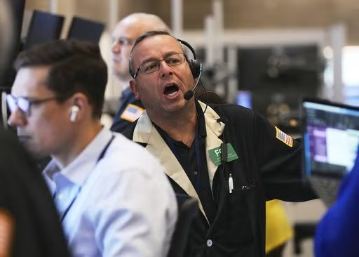World
Wall Street inches higher ahead of revisions to US jobs

Wall Street moved slightly higher on Tuesday as investors positioned themselves ahead of upcoming revisions to U.S. employment data, a report that could provide important clues about the health of the labor market and the trajectory of Federal Reserve policy.
Equity markets have been particularly sensitive to labor figures in recent months, as job growth and wage gains remain central drivers of inflationary pressures. The revisions, expected later this week, will update earlier estimates and may either confirm the view that hiring is cooling or suggest that the labor market is stronger than initially reported. Either outcome carries significant implications for financial markets.
If the data point to a softer jobs environment, investors are likely to interpret it as a signal that the Fed’s aggressive rate-hike campaign has been effective in easing demand, raising hopes for eventual interest-rate cuts. That prospect tends to support equities by lowering borrowing costs and improving corporate earnings outlooks. Conversely, if the revisions show that job creation remains robust, it could strengthen the case for the Fed to keep rates elevated for a longer period, a scenario that often weighs on stocks and heightens volatility.
On Tuesday, trading volumes were subdued, reflecting the market’s wait-and-see attitude. The Dow Jones Industrial Average, S&P 500, and Nasdaq Composite all posted modest gains, with cyclical stocks and interest-rate-sensitive sectors showing the most movement. Meanwhile, bond yields held steady, and the U.S. dollar remained largely unchanged, signaling that broader financial markets are also in a holding pattern until more clarity emerges.
The focus on labor market data comes at a time when investors are searching for signs of balance in the U.S. economy. While inflation has eased from its peak, it remains above the Fed’s 2 percent target. At the same time, consumer spending has shown resilience, supported by steady wage growth, but questions remain about whether households can maintain this momentum if the job market begins to slow more sharply.
In the broader context, Tuesday’s slight gains reflect a cautious optimism. Market participants are willing to take on limited risk in anticipation that softer revisions could support the case for monetary easing, but they remain mindful of the possibility that stronger numbers could once again shift expectations toward prolonged policy tightening.
Market strategists noted that the stakes surrounding the jobs revisions are higher than usual, given the mixed signals coming from other parts of the economy. Manufacturing surveys have shown signs of weakness, housing activity has cooled under the weight of higher mortgage rates, and consumer confidence has wavered in recent weeks. Yet the labor market, despite some easing, has remained remarkably resilient, complicating the Federal Reserve’s efforts to strike a balance between curbing inflation and avoiding a sharp economic slowdown.
“Investors are essentially in a holding pattern,” said one New York-based equity strategist. “The market is looking for confirmation that the labor market is easing in a sustainable way. Too much strength, and the Fed may keep its foot on the brake; too much weakness, and recession fears could quickly return.”
This delicate backdrop has also kept corporate earnings in focus. Companies across sectors have been cautious in their forward guidance, often citing uncertainty about consumer demand and financing conditions. For Wall Street, the jobs data revisions will not only influence expectations for Fed policy but also shape broader sentiment about whether companies can maintain profit margins in the months ahead.
Global factors are adding to the cautious mood. Slower growth in Europe and ongoing concerns about China’s economic recovery have weighed on international demand, while geopolitical risks—from energy markets to trade flows—remain a source of volatility. Against this backdrop, U.S. markets have served as a relative safe haven, but their direction in the near term is still tethered to domestic data.
For now, the modest rise in equities suggests investors are leaning toward optimism, but unwilling to commit too heavily without confirmation from the labor figures. As one portfolio manager put it, “The market doesn’t want to get caught on the wrong side of the Fed. Everyone is waiting to see if these revisions shift the narrative on rates.”

At least 20 people killed in Russian glide bomb attack on village in eastern Ukraine

Transition vs. Physical Risk A decision tree for which risk dominates by industry.

Getting Assurance-Ready — Controls and evidence trails for sustainability data.
trending posts

TOP Categories
Google Web Reporters













3 comments
David Bowie
3 hours agoEmily Johnson Cee
2 dayes agoLuis Diaz
September 25, 2025